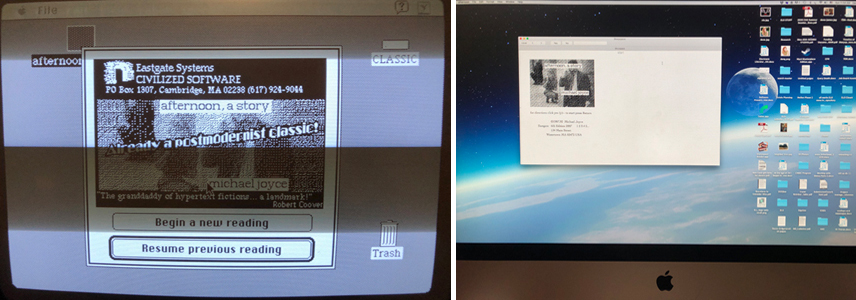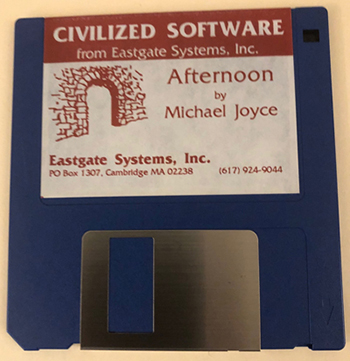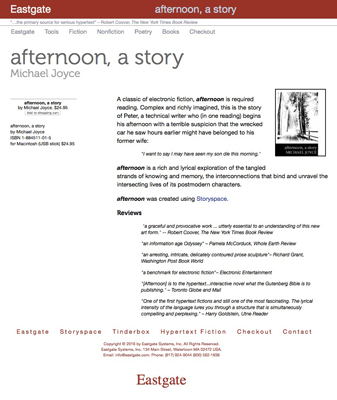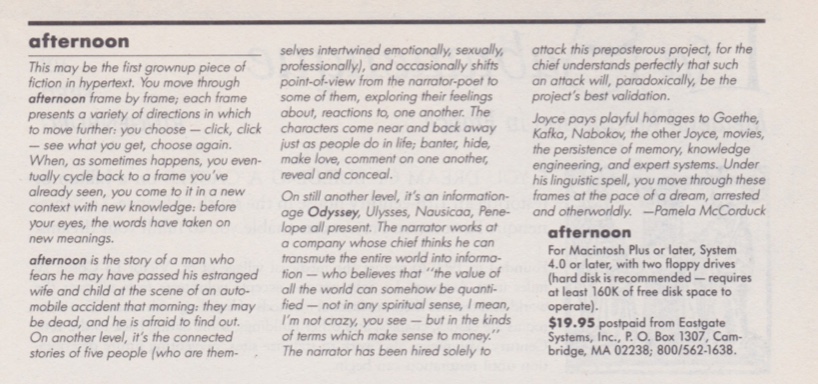An Afternoon with afternoon: An Exhibition Celebrating the 30th Anniversity of Michael Joyce’s afternoon, a story
Curated by Dene Grigar, PhD; Director, the Electronic Literature Lab, Washington State University Vancouver
This year, 2020, marks the 30th anniversary of the commercial publication of Michael Joyce's hypertext novel, afternoon, a story. While editions of it were given out at conferences and to friends in 1987 and 1989, it is 1990 that figures as the date it was sold through the publisher, Eastgate Systems, Inc. Honoring this work such as we are doing with this exhibition and reading is not a nostalgic act but rather one that allows scholars to revisit Joyce's contributions to literary history and situate the novel in contemporary culture, one not that much different from its.
Those of us around during the release of the novel may remember the rave reviews it received from The NYTimes, The Washington Post, The Whole Earth Quarterly, and Wall Street Journal, to name but a few prestigious newspapers and magazines. Scholarly texts like Jay David Bolter's Writing Space (1991) and George Landow's Hypertext (1992) positioned the novel as the "touchstone" (Harpold) both for thinking about the shift in writing (and thinking) and for theorizing about postmodernism, respectively. When it was later published by W. W. Norton & Co. both as new online edition (1997) and excerpt in the Postmodern American Fiction: An Anthology (1998), many of us believed hypertext fiction had formally been recognized as a literary form by the purveyors of print.
We may also remember the mood and tone of the novel, one that reflected the angst arising out of the Reagan-Bush years where trickle-down economics took precedence over needed societal reform. The extension of the Equal Rights Amendment (ERA) that guaranteed the rights of women under the American Constitution was denied in 1981, and it would take over another decade before the U.S. would formally recognize marital rape. The character Werther, presented in a harsh light in Joyce's story for his general lack of respect for women and poor treatment of his wife Lolly, comes to represent today in a world impacted by the #MeToo movement the epitome of the white privileged male whose sexual behavior is less about experimentation (as Werther suggests) and more about exploitation. Joyce's novel questions the subservient roles Black people still played in American culture in the late 1980s, decades after the end of segregation and Jim Crow Laws following the Civil Rights Movement and entreats us to wonder why it has taken three more decades and the Black Lives Matter movement to drive action against police brutality and continued racial discrimination. In effect, this novel—like all classic literary works—compels us to think about and question the world around us and reflect upon our belief systems and ideas. afternoon, a story brings to readers both the beauty of the written word and the pain words can cause when they reveal truths.
In organizing this famous novel for exhibition in 2020, I am confronted with the challenge of presenting a literary work that has taken many forms. To Matthew Kirschenbaum's comment that "there are many Afternoons, even if the literal textual differences between them prove slight" (Mechanisms 162), I would add that differences between the many afternoons are not just "textual" but also structural—and in the ways it has been manifested physically over the years: the devices used to store and provide access to the text (e.g. floppy disks, CD-ROMs, and USB stick), in the numerous software upgrades that impacted the experience with the text, and in the publication for multiple platforms that expanded access to the text. afternoon, a story, is indeed, as both Kirschenbaum and Terry Harpold point out, “unruly” (Kirschenbaum, Mechanisms, 161; Harpold, “Conclusions,” 638)—in which case this exhibition and event could easily be renamed, "An Afternoon with afternoons."
This exhibition, therefore, has two aims. First, it celebrates this “granddaddy of full-length hypertext fictions” (Coover) that essentially gave birth to both a genre and a field. It is indeed a touchstone for many of us who were experimenting with computers to produce expressive writing in late 1990s, for the novel carries forward today, 30 years after its commercial release, as an enduring work of classic fiction, excerpted in a print anthology, documented in scholarly databases, translated into four languages, and found on the shelves of libraries and in special collections all over the world. Its popularity has kept it alive in various forms. Herein lies the need for the second goal of this exhibition: Because afternoon, a story exists in so many manifestations, the exhibition aims to provide information about all heretofore identified of the work and expand on the system used to reference the novel. The latter of these two goals is an important one. As Kirschenbaum points out in Mechanisms: New Media and the Forensic Imagination, the novel
“is typically cited without any acknowledgement or awareness of the differences between its versions, or even the fact that multiple versions exist” (195).
Ironically, this has been an ongoing issue for electronic literature whose accessibility to the public has been maintained over time. Judy Malloy’s Uncle Roger, for example, has existed in seven different iterations over its 34-year history (Grigar, “The Many Faces,” 63, 112), most recently as an emulation of its 1988 version. For this reason, my lab’s Rebooting Electronic Literature project has been working for the last seven years to version works for scholars. This exhibition follows in that vein.
The approach we take in the lab to all our activities centers on the human experience, a concept that involves sensory modalities, along with interaction, immersion, emotional connection, and other potential relationships evoked by or established with a particular work. Experiencing afternoon, a story produced with Storyspace 1.75, published on a floppy disk, and read on a Macintosh LC II running System Software 7.1 with a 12” RGB monitor with a 512 x 384 screen resolution, like I owned in 1992 and used for accessing hypertext fiction, differs from my experience with hypertext fiction produced with Storyspace 3.0, published on a USB Stick, and read on the 27” iMac running MacOS High Sierra (10.13.6) on a screen with a 5120 x 2880 resolution. For one, on the monitor with a smaller screen resolution, the title page from the 1992 Edition dominates the viewer’s attention, while on the monitor with the larger screen resolution, title page from the 2016 Edition is not centered on the screen and the work’s graphic and publication information is situated on the left hand side of the page. Thus, my focus is not drawn directly to it.

Figure 2: View of title pages from 1992 and 2016 Editions
Additionally, the font, “central of the Macintosh experience,” differs greatly between the 1992 and the 2016 Editions in that in the former, the typeface is “jaggy” (Ploudre), so, timestamps the work to the early 1990s while the latter offers a smooth typeface that speaks to the second decade of the 2000s. Gone also from the 2016 Edition is the text promoting the work, calling attention to its position as a “postmodern classic” and Coover’s positive review of it. What's more, readers accessing the 2016 Edition on a Macintosh computer running MacOS X 10.15.5 (Catalina) will not see the graphic featured in Figure 2 at all, thus missing the image the author himself produced for the work. Because experience is impacted by time, encountering the work today when electronic media is the “cultural dominant” (De Kosnik 5-6) is different than when it was first introduced and electronic media was so new. In highlighting the various iterations of afternoon, a story, I draw attention to their specificities. In this way, I heed Kirschenbaum’s notion that
“we need to think about electronic texts in diachronic terms, as objects or artifacts with material histories” (“Editing the Interface” 33).
Thus, I organize the exhibition with the works presented in chronological order from what can considered to be the 1st Edition to the most recent and include commentary about each that focuses on its specific material manifestation—that is, the mode of presentation and the hardware and software required for access. Along with this information, I overlay historical accounts and textual analysis by scholars, the publisher, and Joyce himself.
As daunting as curating afternoon, a story is, considering the robust attention it has received from both critics and theorists throughout its 30-year lifetime, I attempt to present it so that its many manifestitations make sense to the public, both literarily and technically—particularly a public of readers who cannot experience the work themselves.

Figure 3: Floppy disk of afternoon, a story
With the exception of the print excerpt of afternoon, a story published in W. W. Norton & Co.'s Postmodern American Fiction, the novel, like any work of electronic literature, as Stephanie Strickland argues, "relies on code for its creation, preservation, and display" (Strickland, qtd. in Rettberg 5). Tied inextricably to its underlying software, afternoon, a story exists in two realms: as "programmable media" (Cayley, qtd. in Rettberg 3) and literature. The term attributed to its genre—that is, hypertext novel—recognizes this duality and points to a "resistan[ce] to clear lines of demarcation" (Rettberg 9). Its hybrid state as computational literature lends itself to an organization strategy built on both "versions" and "editions." Versions, the "hallmark of electronic textual culture" (Kirschenbaum, Mechanisms, 197), relates to changes to software—Storyspace, as well as Macintosh System Software and OS and Windows OS. For example, when Apple released System Software 6.0.7, Eastgate Systems, Inc. released a new version of afternoon, a story that took advantage of "changes in the underlying the software code" (Kirschenbaum, "Editing the Interface," 30-31). Editions are associated with the print world and has been, heretofore, the way in which afternoon, a story has often been discussed (Kirschenbaum, "Editing the Interface" 27), sometimes loosely. In terms of editions, I borrow Fredson Bowers' notion of edition devised for hand-printed books, defining it as "the whole number of copies of [the work produced] at any time or times from substantially the same [approach]" (Bowers 39) in terms of its underlying code, language, and presentation. There may be many copies made from any one edition over a length of time, but a new edition is identified as the work released again with changes to code, presentation, structure, and/or text. Finally, by "text" I mean "language that is . . . doing some job in some context, as opposed to isolated words or sentences that I might put on the blackboard" (Halliday & Hasan 10). They are, as David M. Levy suggests, "bits of the material world . . . that we create to speak for us and take on jobs for us" (25). Ultimately, text is a "social process" (Dahlström) that can potentially weave together, as N. Katherine Hayles argues, numerous "signifying components" including "sound, animation, motion, video, kinesthetic involvement, and software functionality, among others" (20). In sum, decisions I make about versions and editions take into account a broad notion of what constitutes the work that we know as afternoon, a story.
Normally my lab is able to version works easily because I have built a library of born digital literature and have collected the legacy computers needed to experience them. While I do own nine copies Joyce’s novel, I am missing three editions of the work (1st, 2nd, and the 5th). Finding accurate metadata for the ones I am missing is difficult.

Figure 4: Eastgate Systems, Inc. website
WorldCat, for example, does not always distinguish floppy disks from CD-ROMs. Publication dates for the same version may differ. The 3rd Edition floppy disk is, for example, listed as having been published in 1992 and 1993. The CD-ROM is listed as having been published in 2001 though it was republished in 2007 for computers running MacOS X 10.5 and later. One of the listings for a floppy disk version displays art for the CD-ROM’s insert instead of the art actually used for it. The publisher’s website offers insights but does not list all of the versions of the work the company has released over time, only the current offering published on a USB Stick. This means I rely on the versions I have collected and turn to other scholars to provide me with information about early iterations to which I do not have access.
Figuring largely in my determination are Barnett’s excellent chapter, “Machine-Enhanced (Re)Minding: The Development of Storyspace,” from Memory Machines: The Evolution of Hypertext (2014); and Matthew Kirschenbaum’s insightful essay, “Editing the Interface: Textual Studies and First Generation Electronic Objects” (2002), and his award-winning book, Mechanisms: New Media and the Forensic Imagination (2008). Terry Harpold’s Ex-foliations: Reading Machines and the Upgrade Path provided me with clarity about the editions for Windows computers; his excellent bibliography informed my general approach to numbering the editions. I also draw upon conversations I have had with Joyce, Harpold, Mark Bernstein, and Stuart Moulthrop, and my own memories stemming from my first contact with afternoon, a story as a graduate student studying under noted hypertext scholar Nancy Kaplan.
The numbering system I develop for afternoon, a story builds on the system reported in Harpold's book as well as the colophon of Norton’s Postmodern American Fiction’s special web edition. Like Harpold I count the 1992 edition for Windows computers but also include the one from 1994. Postmodern American Fiction makes no distinction between the Mac and Windows editions in its numbering system, but I do. I follow Harpold's lead concerning the 2001 date of the CD-ROM and add the later edition. Finally, I include the release of the USB Stick edition that came after the publication of the anthology and Harpold's book. In total, I identify 12 editions of afternoon, a story, dating from 1987 to 2016, published in English. There are additionally four translations of the work produced in Polish, Italian, French, and German. While Kirschenbaum calls the 1992 edition "the authoritative edition" ("Editing the Interface" 31), I have found enough variations relating to the structure between the editions published on floppy disk and those published on CD-ROM and USB Stick and for the Macintosh and Windows formats to say that this designation does not last beyond the 6th Edition—that is, the 1994 Macintosh Edition. This explains why the publisher cites that date for the copyright of the 11th Edition, a situation that appeared odd to me initially. Other differences among the editions rest on changes to the platform (move to CD-ROM and USB stick; expansion to Windows) and packaging (change from vinyl to cardboard). I will, no doubt, continue to fine tune this effort as I am able to access copies of editions not currently available to me. I acknowledge and thank these scholars and editors for their brilliant insights and vision because without their contributions, I would not be able to complete this task.

Figure 5: Review of afternoon, a story in Whole Earth Catalog
I have mounted 18 art exhibitions in the last 15 years, but none has ever focused on one work—until now. Even Beyond Grammatron: Twenty Years into the Future, that celebrated Mark Amerika’s 1997 ground-breaking work, Grammatron, still featured net art by six other artists. By presenting afternoon, a story as an exploration of its editions and versions over the 33-year period of its history, I hope scholars become more aware of material specificities of this work (Kirschenbaum, Mechanisms, 195)—as well as other works produced for the computer medium. My work also emphasizes the challenge that digital media poses to the notion of "fixity" that sits at the heart of authoritative editions of born digital literary work. Finally, and most importantly, I pay homage to one of the most influential works of the field and the harbinger for the approaches and thinking underlying 21st interactive media and literature.
Works Cited
Barnett, Belinda. Memory Machines: The Evolution of Hypertext. NY, NY: Anthem Press,
2014.
Bowers, Fredson. Principles of Bibliographic Description. 1994. Princeton, NJ: Princeton
UP, 1998.
Coover, Robert. “The End of Books.” The New York Times Review of Books. June 21, 1992. https://archive.nytimes.com/www.nytimes.com/books/98/09/27/specials/coover-end.html.
Dahlstrom, Mats, "When is a Webtext?". Text Technology : The Journal of Computer Text
Processing. Vol 11 (2002): 1. 139-161.
De Kosnik, Abigail. Rogue Archives: Digital Cultural Memory and Media Fandom. Cambridge,
MA: The MIT Press, 2016.
Grigar, Dene. “The Many Faces of Uncle Roger.” Traversals: The Use of Preservation for
Early Electronic Writing. Stuart Moulthrop and Dene Grigar. Cambridge, MA: The MIT Press,
2017. 61-113.
---. “10 Things I Learned about afternoon: a story.” Pathfinders. 4 May 2016. Blog
post. http://dtc-wsuv.org/wp/pathfinders/2016/05/04/10-things-i-learned-about-afternoon-a-story/.
Grigar, Dene, Nicholas Schiller, et al. “Saying Something about ‘I Have Said Nothing.’” Rebooting Electronic
Literature, Volume 1. June 2018. DOI: 10.7273/NKQK-H488.
Halliday, M. A. K. and Ruqaiya Hasan. Language, Context, and Text: Aspects of Language in a
Social-Semiotic Perspective. Oxford: Oxford University Press, 1985.
Harpold, Terry. Ex-foliations: Reading Machines and the Upgrade Path. Minnesota, MN:
University Minnesota Press, 2009.
---. "Interview with Terry Harpold." 15 June 2020.
Hayles, N. Katherine. Writing Machines. Cambridge, MA: The MIT Press, 2002.
Joyce, Michael. “Letter to Sandra Kroups,” 25 May 1992.
Kirschenbaum, Matthew. “Editing the Interface: Textual Studies and First Generation Electronic
Objects.” Text 14 (2002), 15-51.
---. Mechanism(s): New Media and the Forensic Imagination. Cambridge, MA: The MIT Press.
2008.
Köhler, Doris and Rolf D. Krause. "Nachmittags, eine Geschichte [Afternoon, a Story] (Mac
OS). Translation of Joyce 1992b. 1998.
Levy, David M. "Where's Waldo? : Reflections on Copies and Authenticity in a Digital Environment.
Authenticity in a Digital Environment. Ed. Charles T. Cullen, Charles T., Peter B. Hirtle,
David Levy, Clifford A. Lynch, Jeff Rothenberg. Washington, D.C.: Council on Library and Information
Resources, 2000. 24-31.
Pisarski, Mariusz, Radek Nowakowski, Jakub Jagiełło, and Łukasz Podgórni. Translation of Michael Joyce's afternoon, a
story. Krakow, 2015. http://www.ha.art.pl/zmrok/.
Ploudre, Jonathan. “History of Font Technologies.” Welcome to Low End Mac. 25 May 2000. https://lowendmac.com/2000/a-history-of-font-technologies/.
Regnauld, Arnaud. "Translating afternoon, a story by Michael Joyce, or How to Inhabit a
Spectral Body. Cherchez le texte: Proceedings of the 2013 ELO Conference. Ed. Joe
Tabbi, Gabriel Gaudette, and Dene Grigar. October 2018.
https://scalar.usc.edu/works/cherchez-le-texte-proceedings-of-the-elo-2013-conference/translating-afternoon-a-story-by-michael-joyce-or-how-to-inhabit-a-spectral-body.
Rettberg, Scott. Electronic Literature. Medford, MA: Polity Press, 2019.
Vannini, Walter. Translation of Michael Joyce's afternoon, a story. Ra-dio. Ed. by
Lorenzo Miglioli. Electtrolibri, 1993. https://books.google.com/books?id=UPtTGwAACAAJ.
